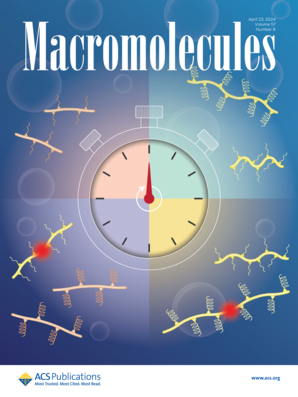Osmotic Pressure-Based Quantification of Network Inhomogeneity in Gels via Free Radical Polymerization
IF 5.1
1区 化学
Q1 POLYMER SCIENCE
引用次数: 0
Abstract
Polymer gels synthesized via free radical polymerization inherently exhibit pronounced network inhomogeneity due to spatially nonuniform cross-linking distributions. While conventional light scattering techniques have been widely used to characterize these inhomogeneities, they lack quantitative reliability, particularly in turbid samples, where multiple scattering complicates analysis. Here, we present a novel macroscopic approach based on osmotic pressure measurements that enables the direct quantification of network inhomogeneity in polymer gels. By comparing the measured osmotic pressure of gels with that predicted for homogeneous semidilute polymer solutions, we quantify the fraction of insoluble polymer domains that contribute negligibly to the overall osmotic pressure. Using poly(N,N-dimethylacrylamide) (PDMAAm) hydrogels as a model system, we find a scaling law that predicts the fraction of insoluble polymer domains as a function of monomer and cross-linker concentrations. This scaling law provides a practical guideline for controlling network inhomogeneity. Our approach establishes a general framework for quantifying insoluble components in gels, overcoming the limitations of conventional semiquantitative characterization techniques.

基于渗透压的自由基聚合法定量测定凝胶中的网络不均匀性
通过自由基聚合合成的聚合物凝胶由于空间上不均匀的交联分布而固有地表现出明显的网络不均匀性。虽然传统的光散射技术已被广泛用于表征这些不均匀性,但它们缺乏定量可靠性,特别是在混浊样品中,其中多次散射使分析复杂化。在这里,我们提出了一种基于渗透压测量的新颖宏观方法,可以直接量化聚合物凝胶中的网络不均匀性。通过比较凝胶的测量渗透压与均匀半稀聚合物溶液的预测渗透压,我们量化了对总渗透压贡献可忽略不计的不溶性聚合物域的比例。使用聚(N,N-二甲基丙烯酰胺)(PDMAAm)水凝胶作为模型体系,我们发现了一个标度定律,该定律预测了不溶性聚合物结构域的比例作为单体和交联剂浓度的函数。该比例律为控制网络非均匀性提供了实用的指导。我们的方法为定量凝胶中的不溶性成分建立了一个总体框架,克服了传统半定量表征技术的局限性。
本文章由计算机程序翻译,如有差异,请以英文原文为准。
求助全文
约1分钟内获得全文
求助全文
来源期刊

Macromolecules
工程技术-高分子科学
CiteScore
9.30
自引率
16.40%
发文量
942
审稿时长
2 months
期刊介绍:
Macromolecules publishes original, fundamental, and impactful research on all aspects of polymer science. Topics of interest include synthesis (e.g., controlled polymerizations, polymerization catalysis, post polymerization modification, new monomer structures and polymer architectures, and polymerization mechanisms/kinetics analysis); phase behavior, thermodynamics, dynamic, and ordering/disordering phenomena (e.g., self-assembly, gelation, crystallization, solution/melt/solid-state characteristics); structure and properties (e.g., mechanical and rheological properties, surface/interfacial characteristics, electronic and transport properties); new state of the art characterization (e.g., spectroscopy, scattering, microscopy, rheology), simulation (e.g., Monte Carlo, molecular dynamics, multi-scale/coarse-grained modeling), and theoretical methods. Renewable/sustainable polymers, polymer networks, responsive polymers, electro-, magneto- and opto-active macromolecules, inorganic polymers, charge-transporting polymers (ion-containing, semiconducting, and conducting), nanostructured polymers, and polymer composites are also of interest. Typical papers published in Macromolecules showcase important and innovative concepts, experimental methods/observations, and theoretical/computational approaches that demonstrate a fundamental advance in the understanding of polymers.
 求助内容:
求助内容: 应助结果提醒方式:
应助结果提醒方式:


